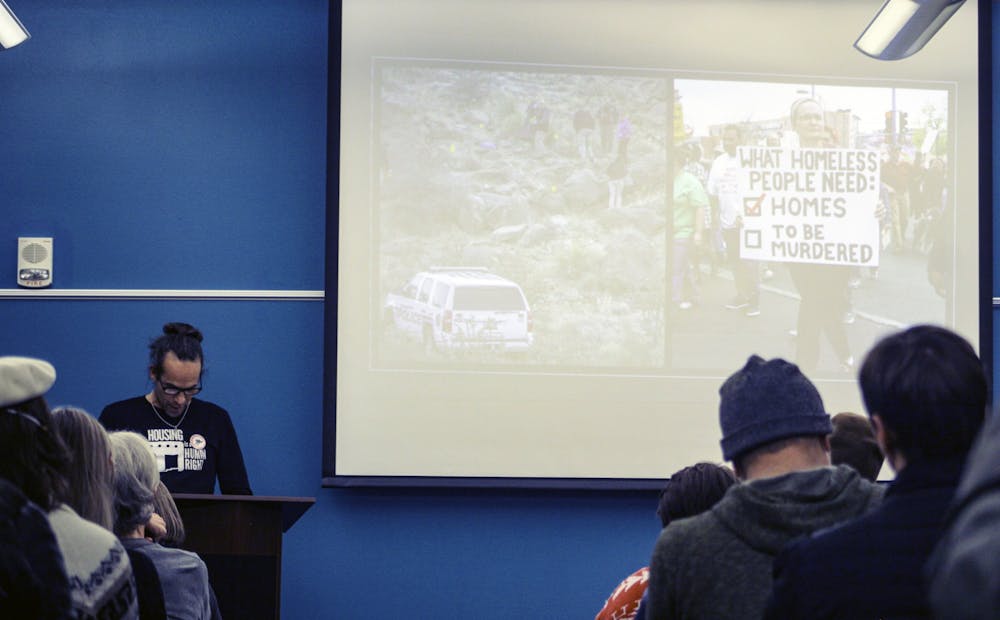On the evening of Thursday, Nov. 17, professor Ernesto Longa, a University of New Mexico law librarian, discussed the data he collected surrounding the frequency and circumstances of the arrests of unhoused individuals in Albuquerque. Dozens of community members gathered in the Student Union Building for a lecture held by Salt of the Earth School, in tandem with Students for Socialism.
“The statistical summary and key points provided today are based on an inspection of nearly 2,000 misdemeanor felony cases which were filed against 867 unhoused individuals in 2020,” Longa said.
The top three most common offenses for unhoused individuals were misdemeanor trespasses against property, interference with law enforcement and misdemeanor larceny — predominantly shoplifting, according to Longa. The other offenses included disorderly conduct, public indecency and simple drug possession. Longa referenced several examples of case briefs from criminal complaints during the lecture.
“The unhoused were charged with committing 3,017 (crimes). 85% of those crimes were classified as misdemeanors and 15% were classified as felonies. The most common category of charges filed against the unhoused was for misdemeanor trespasses against property,” Longa said.
Since the Albuquerque Police Department’s reports do not specifically note whether an individual is unhoused or not, Longa used other identifiers on the document for the purpose of his research. The identifiers included the individual being described as homeless or unhoused, a shelter listed as their address, or if they were arrested for a crime a housed individual is less likely to commit, like pitching a tent in a park.
“I did uncover 867 individuals as being unhoused, but there's a lot of gray area because certain traffic infractions, driving on a revoked license, coupled with insurance and registration issues, (you) can easily imagine people who are living in their cars or vehicles who go undetected through some of these means are just not identified as homeless. So I do believe this is a fairly conservative number, although seemingly large,” Longa said.
The data in the set was made up of 31% white, 26% Hispanic, 19% American Indian, 9% Black and 14% unknown individuals. American Indians are less than 5% of the entire Albuquerque population and Black individuals are approximately 3%, according to Longa.
There also is an underreporting of mental illness in unhoused individuals, according to Longa, due to most cases not going to trial and never being assessed. Around 12% of the unhoused in the data set were listed as incompetent to stand trial by the courts, but according to a U.S. Housing and Urban Development Report, 25% of the unhoused in New Mexico are “severely mentally ill.”
In APD’s use of force report, out of 1,000 police calls, only 3.2% of cases out of 1,000 calls are responded to with force. However, most calls do not have officers sent to the scene, according to Longa.
“This is a rather misleading statistic. Since many calls for service do not result in an interaction …. a more accurate measure of the frequency in which APD uses force would be to report the number of force cases per interaction. In the cases I surveyed, police has reported 72 use of force incidents against the unhoused, 39 force cases per 1,000 interactions,” Longa said.
In 2014, a U.S. Department of Justice investigation found that APD uses excessive force at a rate that violates federal law. In response, APD must now have an independent review conducted to assess the use of force. The review that covered part of the Longa’s data set showed that APD has continued to use excessive force despite the independent reviews.
Longa also discussed fines that accompany arrests, which most unhoused individuals serve as jail time in the absence of payment.
Get content from The Daily Lobo delivered to your inbox
“The courts issued 1,917 warrants against 716 unhoused individuals, and each time a warrant was issued, a $100 fine. Additional fees were assigned to defendants when they were convicted. And as of July 1, 2022, the court had assessed nearly a quarter-million dollars in fines and fees against just 737 on housing. Two-thirds of them paid off their debt by serving time in jail referred to in the case file or register of actions as jail in lieu of fines and fees,” Longa said.
The Albuquerque Community Service Department, which was introduced as an alternate option to the police to be dispatched in mental health crises and situations where law enforcement is not necessary, received 8,224 calls in its first six months. Since they receive a considerably smaller budget and have limited hours of service, this data was not considered in the study, according to Longa.
Maddie Pukite is the managing editor at the Daily Lobo. They can be contacted at managingeditor@dailylobo.com or on Twitter @maddogpukite






